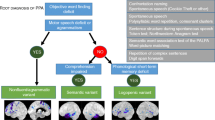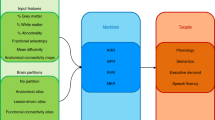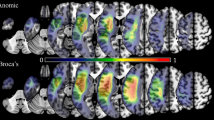Abstract
Purpose of Review
Aphasia is often characterized in terms of subtype and severity, yet these constructs have limited explanatory power, because aphasia is inherently multifactorial both in its neural substrates and in its symptomatology. The purpose of this review is to survey current and emerging multivariate approaches to understanding aphasia.
Recent Findings
Techniques such as factor analysis and principal component analysis have been used to define latent underlying factors that can account for performance on batteries of speech and language tests, and for characteristics of spontaneous speech production. Multivariate lesion-symptom mapping has been shown to outperform univariate approaches to lesion-symptom mapping for identifying brain regions where damage is associated with specific speech and language deficits. It is increasingly clear that structural damage results in functional changes in wider neural networks, which mediate speech and language outcomes.
Summary
Multivariate statistical approaches are essential for understanding the complex relationships between the neural substrates of aphasia, and resultant profiles of speech and language function.
Similar content being viewed by others
References
Papers of particular interest, published recently, have been highlighted as: • Of importance
Wernicke C. Der Aphasische Symptomencomplex. Breslau: Cohn and Weigert; 1874.
Lichtheim L. On aphasia. Brain. 1885;7:433–84.
Geschwind N. Disconnexion syndromes in animals and man. I Brain. 1965;88:237–94.
Geschwind N. Disconnexion syndromes in animals and man. II Brain. 1965;88:585–644.
Goodglass H, Kaplan E. The assessment of aphasia and related disorders. 1st ed. Philadelphia: Lea and Febiger; 1972.
Marie P. La troisième circonvolution frontal gauche ne joue aucun rôle spécial dans la fonction du langage. Sem Médicale. 1906;26:241–7.
Goldstein K. Language and language disturbances. New York: Grune and Stratton; 1948.
Schuell H, Jenkins JJ, Jimenez-Pabon E. Aphasia in adults. New York: Harper & Row; 1964.
Corbetta M, Siegel JS, Shulman GL. On the low dimensionality of behavioral deficits and alterations of brain network connectivity after focal injury. Cortex. 2018;107:229–37.
Hickok G, Poeppel D. The cortical organization of speech processing. Nat Rev Neurosci. 2007;8:393–402.
Price CJ. A review and synthesis of the first 20 years of PET and fMRI studies of heard speech, spoken language and reading. NeuroImage. 2012;62:816–47.
Wilson SM, Bautista A, McCarron A. Convergence of spoken and written language processing in the superior temporal sulcus. NeuroImage. 2018;171:62–74.
Fedorenko E, Thompson-Schill SL. Reworking the language network. Trends Cogn Sci. 2014;18:120–6.
Geranmayeh F, Brownsett SLE, Wise RJS. Task-induced brain activity in aphasic stroke patients: what is driving recovery? Brain. 2014;137:2632–48.
Yen M, DeMarco AT, Wilson SM. Adaptive paradigms for mapping phonological regions in individual participants. NeuroImage. 2019;189:368–79.
Seeley WW, Crawford RK, Zhou J, Miller BL, Greicius MD. Neurodegenerative diseases target large-scale human brain networks. Neuron. 2009;62:42–52.
Turkeltaub PE, Messing S, Norise C, Hamilton RH. Are networks for residual language function and recovery consistent across aphasic patients? Neurology. 2011;76:1726–34.
Wilson SM, Brambati SM, Henry RG, Handwerker DA, Agosta F, Miller BL, et al. The neural basis of surface dyslexia in semantic dementia. Brain. 2009;132:71–86.
Jones LV, Wepman JM. Dimensions of language performance in aphasia. J Speech Hear Res. 1961;4:220–32.
Schuell H, Jenkins JJ, Carroll JB. A factor analysis of the Minnesota Test for Differential Diagnosis of Aphasia. J Speech Hear Res. 1962;5:349–69.
Kertesz A, Phipps J. Numerical taxonomy of aphasia. Brain Lang. 1977;4:1–10.
Clark C, Crockett DJ, Klonoff H. Factor analysis of the Porch Index of Communication Ability. Brain Lang. 1979;7:1–7.
Clark C, Crockett DJ, Klonoff H. Empirically derived groups in the assessment of recovery from aphasia. Brain Lang. 1979;7:240–51.
Hanson WR, Riege WH, Metter EJ, Inman VW. Factor-derived categories of chronic aphasia. Brain Lang. 1982;15:369–80.
Swinburn K, Porter G, Howard D. Comprehensive Aphasia Test. Hove: Psychology Press; 2004.
Goodglass H, Kaplan E. The assessment of aphasia and related disorders. 2nd ed. Philadelphia: Lea and Febiger; 1983.
Hula WD, Doyle PJ, Stone CA, Austermann Hula SN, Kellough S, Wambaugh JL, et al. The Aphasia Communication Outcome Measure (ACOM): dimensionality, item bank calibration, and initial validation. J Speech Lang Hear Res. 2015;58:906–19.
Butler RA, Ralph MAL, Woollams AM. Capturing multidimensionality in stroke aphasia: mapping principal behavioural components to neural structures. Brain. 2014;137:3248–66.
Mirman D, Chen Q, Zhang Y, Wang Z, Faseyitan OK, Coslett HB, et al. Neural organization of spoken language revealed by lesion-symptom mapping. Nat Commun. 2015;6:6762 Applied PCA to a battery of language measures to identify four underlying components, and then used lesion-symptom mapping to show that each component was associated with damage to specific brain regions.
Mirman D, Zhang Y, Wang Z, Coslett HB, Schwartz MF. The ins and outs of meaning: behavioral and neuroanatomical dissociation of semantically-driven word retrieval and multimodal semantic recognition in aphasia. Neuropsychologia. 2015;76:208–19.
Fridriksson J, Yourganov G, Bonilha L, Basilakos A, Den Ouden D-B, Rorden C. Revealing the dual streams of speech processing. Proc Natl Acad Sci U S A. 2016;113:15108–13.
Fridriksson J, den Ouden D-B, Hillis AE, Hickok G, Rorden C, Basilakos A, et al. Anatomy of aphasia revisited. Brain. 2018;141:848–62.
Halai AD, Woollams AM, Ralph MAL. Using principal component analysis to capture individual differences within a unified neuropsychological model of chronic post-stroke aphasia: revealing the unique neural correlates of speech fluency, phonology and semantics. Cortex. 2017;86:275–89.
Schwartz MF, Dell GS, Martin N, Gahl S, Sobel P. A case-series test of the interactive two-step model of lexical access: evidence from picture naming. J Mem Lang. 2006;54:228–64.
Wagenaar E, Snow C, Prins R. Spontaneous speech of aphasic patients: a psycholinguistic analysis. Brain Lang. 1975;2:281–303.
Vermeulen J, Bastiaanse R, Van Wageningen B. Spontaneous speech in aphasia: a correlational study. Brain Lang. 1989;36:252–74.
Casilio M, Rising K, Beeson PM, Bunton K, Wilson SM. Auditory-perceptual rating of connected speech in aphasia. Am J Speech Lang Pathol. 2019;28:550–68.
DeDe G, Caplan D. Factor analysis of aphasic syntactic comprehension disorders. Aphasiology. 2006;20:123–35.
Caplan D, Waters G, DeDe G, Michaud J, Reddy A. A study of syntactic processing in aphasia I: behavioral (psycholinguistic) aspects. Brain Lang. 2007;101:103–50.
Caplan D, Michaud J, Hufford R. Dissociations and associations of performance in syntactic comprehension in aphasia and their implications for the nature of aphasic deficits. Brain Lang. 2013;127:21–33.
Floyd FJ, Widaman KF. Factor analysis in the development and refinement of clinical assessment instruments. Psychol Assess. 1995;7:286–99.
Fabrigar LR, Wegener DT, MacCallum RC, Strahan EJ. Evaluating the use of exploratory factor analysis in psychological research. Psychol Methods. 1999;4:272–99.
Tabachnick BG, Fidell LS. Using multivariate statistics. 6th ed. Boston: Pearson; 2007.
Fergadiotis G, Wright HH, West TM. Measuring lexical diversity in narrative discourse of people with aphasia. Am J Speech Lang Pathol. 2013;22:S397–408.
. Walker GM, Hickok G, Fridriksson J. A cognitive psychometric model for assessment of picture naming abilities in aphasia. Psychol Assess. 2018;30:809–26 Developed an innovative multidimensional cognitive psychometric model of picture-naming with theoretical and clinical utility, and provided preliminary validity evidence.
Batchelder WH. Multinomial processing tree models and psychological assessment. Psychol Assess. 1998;10:331–44.
Erdfelder E, Auer T-S, Hilbig BE, Aßfalg A, Moshagen M, Nadarevic L. Multinomial processing tree models: a review of the literature. J Psychol. 2009;217:108–24.
Lord FM, Novick MR, Birnbaum A. Statistical theories of mental test scores. Oxford: Addison-Wesley; 1968.
Edelen MO, Reeve BB. Applying item response theory (IRT) modeling to questionnaire development, evaluation, and refinement. Qual Life Res. 2007;16:5–18.
del Toro CM, Bislick LP, Comer M, Velozo C, Romero S, Rothi LJG, et al. Development of a short form of the Boston Naming Test for individuals with aphasia. J Speech Lang Hear Res. 2011;54:1089–100.
Fergadiotis G, Kellough S, Hula WD. Item response theory modeling of the Philadelphia Naming Test. J Speech Lang Hear Res. 2015;58:865–77.
Mohr JP. Broca’s area and Broca’s aphasia. In: Whitaker H, Whitaker H, editors. Studies in neurolinguistics, vol. 1. New York: Academic Press; 1976.
Damasio H, Grabowski TJ, Tranel D, Hichwa RD, Damasio AR. A neural basis for lexical retrieval. Nature. 1996;380:499–505.
Bates E, Wilson SM, Saygin AP, Dick F, Sereno MI, Knight RT, et al. Voxel-based lesion-symptom mapping. Nat Neurosci. 2003;6:448–50.
Ashburner J, Friston KJ. Voxel-based morphometry--the methods. NeuroImage. 2000;11:805–21.
Schwartz MF, Kimberg DY, Walker GM, Faseyitan O, Brecher A, Dell GS, et al. Anterior temporal involvement in semantic word retrieval: voxel-based lesion-symptom mapping evidence from aphasia. Brain. 2009;132:3411–27.
Wilson SM, Henry ML, Besbris M, Ogar JM, Dronkers NF, Jarrold W, et al. Connected speech production in three variants of primary progressive aphasia. Brain. 2010;133:2069–88.
Rorden C, Karnath HO. Using human brain lesions to infer function: a relic from a past era in the fMRI age? Nat Rev Neurosci. 2004;5:812–9.
Husain M, Nachev P. Space and the parietal cortex. Trends Cogn Sci. 2007;11:30–6.
Mah Y-H, Husain M, Rees G, Nachev P. Human brain lesion-deficit inference remapped. Brain. 2014;37:2522–31.
Herbet G, Lafargue G, Duffau H. Rethinking voxel-wise lesion-deficit analysis: a new challenge for computational neuropsychology. Cortex. 2015;64:413–6.
Xu T, Jha A, Nachev P. The dimensionalities of lesion-deficit mapping. Neuropsychologia. 2018;115:134–41 Explained the negative consequences of univariate approaches to lesion-symptom mapping ignoring patterns of lesion distribution and distal effects of lesions, and advocated multivariate alternatives and systematic evaluation with synthetic data.
Inoue K, Madhyastha T, Rudrauf D, Mehta S, Grabowski T. What affects detectability of lesion-deficit relationships in lesion studies? NeuroImage Clin. 2014;6:388–97.
Sperber C, Karnath H-O. Impact of correction factors in human brain lesion-behavior inference. Hum Brain Mapp. 2017;38:1692–701.
Wilson SM, Lam D, Babiak MC, Perry DW, Shih T, Hess CP, et al. Transient aphasias after left hemisphere resective surgery. J Neurosurg. 2015;123:581–93.
Bonilha L, Fridriksson J. Subcortical damage and white matter disconnection associated with non-fluent speech. Brain. 2009;132:e108.
Corbetta M, Ramsey L, Callejas A, Baldassarre A, Hacker CD, Siegel JS, et al. Common behavioral clusters and subcortical anatomy in stroke. Neuron. 2015;85:927–41.
Siegel JS, Ramsey LE, Snyder AZ, Metcalf NV, Chacko RV, Weinberger K, et al. Disruptions of network connectivity predict impairment in multiple behavioral domains after stroke. Proc Natl Acad Sci U S A. 2016;113:E4367–76 Many post-stroke deficits, including aphasia, can be predicted based on measure of functional connectivity, especially reduced interhemispheric communication.
Caplan D, Waters G, Kennedy D, Alpert N, Makris N, Dede G, et al. A study of syntactic processing in aphasia II: neurological aspects. Brain Lang. 2007;101:151–77.
Wilson SM, Ogar JM, Laluz V, Growdon M, Jang J, Glenn S, et al. Automated MRI-based classification of primary progressive aphasia variants. NeuroImage. 2009;47:1558–67.
Zhang Y, Kimberg DY, Coslett HB, Schwartz MF, Wang Z. Multivariate lesion-symptom mapping using support vector regression. Hum Brain Mapp. 2014;35:5861–76.
Pustina D, Coslett HB, Ungar L, Faseyitan OK, Medaglia JD, Avants B, et al. Enhanced estimations of post-stroke aphasia severity using stacked multimodal predictions. Hum Brain Mapp. 2017;38:5603–15.
Hope TMH, Seghier ML, Leff AP, Price CJ. Predicting outcome and recovery after stroke with lesions extracted from MRI images. NeuroImage Clin. 2013;2:424–33.
Chen R, Hillis AE, Pawlak M, Herskovits EH. Voxelwise Bayesian lesion-deficit analysis. NeuroImage. 2008;40:1633–42.
Vapnik V. Statistical learning theory. New York: Wiley; 1998.
Yourganov G, Smith KG, Fridriksson J, Rorden C. Predicting aphasia type from brain damage measured with structural MRI. Cortex. 2015;73:203–15.
Yourganov G, Fridriksson J, Rorden C, Gleichgerrcht E, Bonilha L. Multivariate connectome-based symptom mapping in post-stroke patients: networks supporting language and speech. J Neurosci. 2016;36:6668–79.
Saur D, Ronneberger O, Kümmerer D, Mader I, Weiller C, Klöppel S. Early functional magnetic resonance imaging activations predict language outcome after stroke. Brain. 2010;133:1252–64.
Xing S, Lacey EH, Skipper-Kallal LM, Jiang X, Harris-Love ML, Zeng J, et al. Right hemisphere grey matter structure and language outcomes in chronic left hemisphere stroke. Brain. 2015;139:227–41.
Lacey EH, Skipper-Kallal LM, Xing S, Fama ME, Turkeltaub PE. Mapping common aphasia assessments to underlying cognitive processes and their neural substrates. Neurorehabil Neural Repair. 2017;31:442–50.
DeMarco AT, Turkeltaub PE. A multivariate lesion symptom mapping toolbox and examination of lesion-volume biases and correction methods in lesion-symptom mapping. Hum Brain Mapp. 2018;39:4169–82.
Pustina D, Avants B, Faseyitan OK, Medaglia JD, Coslett HB. Improved accuracy of lesion to symptom mapping with multivariate sparse canonical correlations. Neuropsychologia. 2018;115:154–66 Described a new approach to multivariate lesion-symptom mapping, and demonstrated that it outperformed a univariate approach on simulated and real aphasia data.
Thye M, Mirman D. Relative contributions of lesion location and lesion size to predictions of varied language deficits in post-stroke aphasia. NeuroImage Clin. 2018;20:1129–38.
Wilson SM, DeMarco AT, Henry ML, Gesierich B, Babiak M, Miller BL, et al. Variable disruption of a syntactic processing network in primary progressive aphasia. Brain. 2016;139:2994–3006.
Griffis JC, Nenert R, Allendorfer JB, Szaflarski JP. Linking left hemispheric tissue preservation to fMRI language task activation in chronic stroke patients. Cortex. 2017;96:1–18.
Griffis JC, Nenert R, Allendorfer JB, Vannest J, Holland S, Dietz A, et al. The canonical semantic network supports residual language function in chronic post-stroke aphasia. Hum Brain Mapp. 2017;38:1636–58.
Skipper-Kallal LM, Lacey EH, Xing S, Turkeltaub PE. Functional activation independently contributes to naming ability and relates to lesion site in post-stroke aphasia: lesion site, activity, and naming in stroke. Hum Brain Mapp. 2017;38:2051–66.
Skipper-Kallal LM, Lacey EH, Xing S, Turkeltaub PE. Right hemisphere remapping of naming functions depends on lesion size and location in poststroke aphasia. Neural Plast. 2017;2017:8740353.
Ramsey LE, Siegel JS, Lang CE, Strube M, Shulman GL, Corbetta M. Behavioural clusters and predictors of performance during recovery from stroke. Nat Hum Behav. 2017;1:0038.
Siegel JS, Seitzman BA, Ramsey LE, Ortega M, Gordon EM, Dosenbach NUF, et al. Re-emergence of modular brain networks in stroke recovery. Cortex. 2018;101:44–59.
Bonilha L, Rorden C, Fridriksson J. Assessing the clinical effect of residual cortical disconnection after ischemic strokes. Stroke. 2014;45:988–93.
Marebwa BK, Fridriksson J, Yourganov G, Feenaughty L, Rorden C, Bonilha L. Chronic post-stroke aphasia severity is determined by fragmentation of residual white matter networks. Sci Rep. 2017;7:8188.
Seghier ML, Patel E, Prejawa S, Ramsden S, Selmer A, Lim L, et al. The PLORAS database: a data repository for predicting language outcome and recovery after stroke. NeuroImage. 2016;124:1208–12.
MacWhinney B, Fromm D. AphasiaBank as BigData. Semin Speech Lang. 2016;37:10–22.
Lukic S, Barbieri E, Wang X, Caplan D, Kiran S, Rapp B, et al. Right hemisphere grey matter volume and language functions in stroke aphasia. Neural Plast. 2017;2017:5601509.
Acknowledgments
The authors thank Andrew T. DeMarco for helpful comments on an earlier version of this manuscript.
Author information
Authors and Affiliations
Corresponding author
Ethics declarations
Conflict of Interest
Stephen M. Wilson declares no potential conflicts of interest. William D. Hula reports grants from NIDCD (R01 DC013270, R21 DC016080), during the conduct of the study.
Human and Animal Rights and Informed Consent
This article does not contain any studies with human or animal subjects performed by any of the authors.
Additional information
Publisher’s Note
Springer Nature remains neutral with regard to jurisdictional claims in published maps and institutional affiliations.
This article is part of the Topical Collection on Behavior
Rights and permissions
About this article
Cite this article
Wilson, S.M., Hula, W.D. Multivariate Approaches to Understanding Aphasia and its Neural Substrates. Curr Neurol Neurosci Rep 19, 53 (2019). https://doi.org/10.1007/s11910-019-0971-6
Published:
DOI: https://doi.org/10.1007/s11910-019-0971-6




